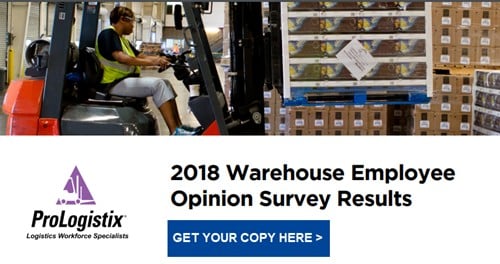
Despite low unemployment and a long-term economic growth streak with record profits now approaching a full decade, distribution centers and warehouses have continued to experience trouble retaining skilled or experienced staff. The problem lies more in how management values the contribution of their people in those facilities – which also makes it somewhat easier to resolve. Today we look into the problem with the help of some great research from ProLogistix through the WERC organization.
Background – The Devaluation of The DC Worker
 One aspect that has to be highlighted up front is that despite a twenty-year period of exponential growth in eCommerce and direct-to-consumer sales, the resulting boom in growth of warehouse space, equipment investment and hiring, it has not resulting in better pay for the people who are now often the last touch of a product before it reaches a customer.
One aspect that has to be highlighted up front is that despite a twenty-year period of exponential growth in eCommerce and direct-to-consumer sales, the resulting boom in growth of warehouse space, equipment investment and hiring, it has not resulting in better pay for the people who are now often the last touch of a product before it reaches a customer.
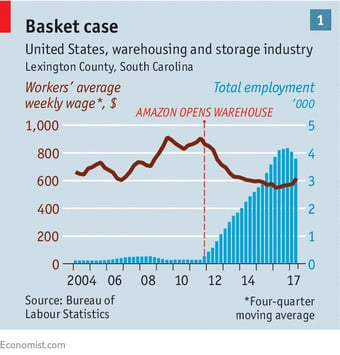
A recent article from The Economist noted that various studies have shown a couple of interesting trends where warehouse worker pay is concerned.
The graph shows a typical example, Lexington County, South Carolina, citing Bureau of Labor Statistics where despite moderate wage growth for many of the ten years prior to their arrival, average annual earnings for warehouse workers dropped 30% (from $47,000 to $32,000) after Amazon opened a DC there. Similar trends are seen all around the US in the locations where Amazing operates the 110+ different facilities it has including Tracy, CA (-16%) and Chesterfield, VA (-17%). The average across the US shows a quick 3% drop in average wages, and compared to regions without an Amazon facility, a difference of almost 10%.
So, despite the fact that so much more of everyone’s business goes through a DC than before, the demand for workers in this space has not generated wage growth for most of them. This is at the core of many of the industries problems. Surprisingly though, Amazon’s practices may not be the problem , but part of the solution.
Five Ways to Improve Retention of Warehouse Workers
- Benefits – Ironically, one study suggests that part of the reason that Amazon can hire for lower wages is that they do offer its full-time employees health care, retirement savings plans, and company shares. For many people that struggle to work with the dysfunctional health-care market or have little or no means to save for retirement, these benefits can make a huge difference when choosing potential employers in a tight labor market. It is not hard to see the math that of healthcare being worth more than a small annual raise.
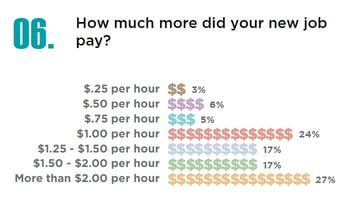 Wages – Not surprisingly, in an annual survey of warehouse workers conducted by ProLogistix, pay figures most prominently as a factor in deciding where to work. In fact, in eleven years of doing the survey it has ranked #1 every single year in a list of ten “priorities”. For those who were new in their jobs, 27% reported a $2/hour increase in wages at their new job. Another 58% gained between $1 and $1.99 per hour. In other words, for only $1-$2/hour, you can retain up to 85% of those how might leave for better pay.
Wages – Not surprisingly, in an annual survey of warehouse workers conducted by ProLogistix, pay figures most prominently as a factor in deciding where to work. In fact, in eleven years of doing the survey it has ranked #1 every single year in a list of ten “priorities”. For those who were new in their jobs, 27% reported a $2/hour increase in wages at their new job. Another 58% gained between $1 and $1.99 per hour. In other words, for only $1-$2/hour, you can retain up to 85% of those how might leave for better pay.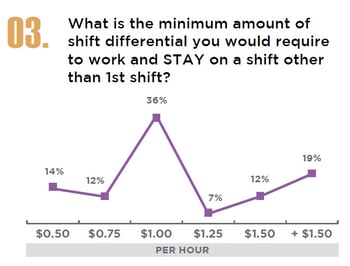 Paid Vacation – From the same ProLogistix Survey, when asked their preference of 5 days paid vacation or $1.00 per hour more in pay with NO paid vacation, workers overwhelmingly chose the former 87% - 13%! Consider that giving someone working 35 hours per week for $12/hour would work about 1750 hours per year and gain $1,750 from the raise. Now consider a week of paid vacation for the same $12/hour would only cost you $380. Workers are being very clear that money isn’t everything and improving their morale and loyalty doesn’t always need to be as expensive as some raises would be.
Paid Vacation – From the same ProLogistix Survey, when asked their preference of 5 days paid vacation or $1.00 per hour more in pay with NO paid vacation, workers overwhelmingly chose the former 87% - 13%! Consider that giving someone working 35 hours per week for $12/hour would work about 1750 hours per year and gain $1,750 from the raise. Now consider a week of paid vacation for the same $12/hour would only cost you $380. Workers are being very clear that money isn’t everything and improving their morale and loyalty doesn’t always need to be as expensive as some raises would be.-
Bonus Tip – Respondents were equally divided between shift length with less than half (49%) choosing the standard 5 day/8 hour structure and a plurality choosing alternatives like 4 day/10 hour (37%) and 3-4 day/12 hours shifts (14%). Depending on your business, some of these may work, though NO single structure will make everyone happy. However, if you have large seasonal swings, for example, testing a 4 day/10-hour model in Summer might be a great way to give everyone more “time off” in summer without increasing pay or other benefits.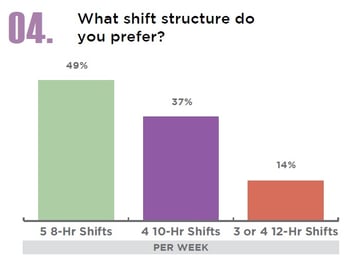 Shift Differentiation – Who wants to work 2nd and 3rd shift? Well, about 33% of the survey respondents do. But if you look at the same ProLogistix survey that shows nearly half of all respondents are also working a second job. So it’s very possible many of those are not thrilled about the 2nd shift if they could live on one job. But using a facility 24/7 is almost always preferable to tripling your space to provide 9-5 shifts for everyone. And there are those who genuinely prefer working out of synch with the rest of the world’s traffic problems. But moving to a different shift when it is not your preference is a disruptive move for most people with implications for family time and personal activities. But for $1 per hour or more, 74% of survey respondents indicated they would find it acceptable to work an alternate shift. The key thing to remember is that if you give an extra $1 for a second shift, it makes it easy for that worker to move to another job for the same pay to go back to a first shift, so this incentive needs to be considered carefully.
Shift Differentiation – Who wants to work 2nd and 3rd shift? Well, about 33% of the survey respondents do. But if you look at the same ProLogistix survey that shows nearly half of all respondents are also working a second job. So it’s very possible many of those are not thrilled about the 2nd shift if they could live on one job. But using a facility 24/7 is almost always preferable to tripling your space to provide 9-5 shifts for everyone. And there are those who genuinely prefer working out of synch with the rest of the world’s traffic problems. But moving to a different shift when it is not your preference is a disruptive move for most people with implications for family time and personal activities. But for $1 per hour or more, 74% of survey respondents indicated they would find it acceptable to work an alternate shift. The key thing to remember is that if you give an extra $1 for a second shift, it makes it easy for that worker to move to another job for the same pay to go back to a first shift, so this incentive needs to be considered carefully. - Unionize – Yes, this is a radical idea. However, smart businesses with unions work with them intelligently to maximize benefits for both the business and employees if it means better productivity and retention. Consider how much work a union does to educate and train new employees on the work culture, basic workplace rules, etc. and in a sense, you have a potential on-floor HR department that saves you time and energy through a partnership with your employees. While this model is something Germany is known for, there are businesses in the US which have successfully embraced a union as a partner to grow the business productively. This option is NOT for everyone, but if you have a business where skills are important, difficult to replace AND retention is a constant challenge, taking a look at other businesses with successes and failures here might be a good idea.
One Size Doesn’t Fit All
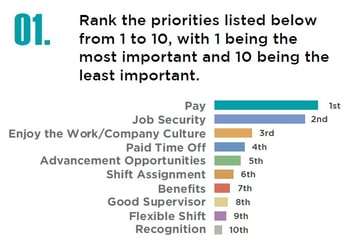 One thing to remember – your location, company culture, industry, skill requirements, etc. are all going to be factors in determining why you have churn and what the solutions are to improving it. In the aforementioned ProLogistix survey, while pay and job security are overwhelmingly the top 2 priorities for workers, the #3 Priority was one that you have absolute control over and can often be managed without great cost and just better relationship management – “Enjoy the work/Company Culture”. So before you jump into a big project to implement one or more of these ideas (or others), take some time doing your “Gemba walks”, do some listening and be intentional about finding out what keeps your team happy. They might point you to the solution that works best for you.
One thing to remember – your location, company culture, industry, skill requirements, etc. are all going to be factors in determining why you have churn and what the solutions are to improving it. In the aforementioned ProLogistix survey, while pay and job security are overwhelmingly the top 2 priorities for workers, the #3 Priority was one that you have absolute control over and can often be managed without great cost and just better relationship management – “Enjoy the work/Company Culture”. So before you jump into a big project to implement one or more of these ideas (or others), take some time doing your “Gemba walks”, do some listening and be intentional about finding out what keeps your team happy. They might point you to the solution that works best for you.
